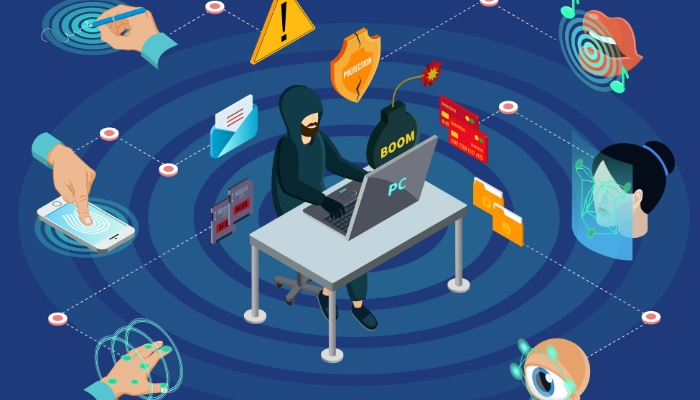Cybersecurity Risk Management in the Real World
Cybersecurity risk management is a critical aspect of modern businesses' operations. With the proliferation of online transactions, the growing amount of sensitive data being stored online, and the increasing sophistication of cyber-attacks, managing cybersecurity risks has become a key challenge for organizations of all sizes. This blog post will explore the topic of cybersecurity risk management in the real world and provide tips for protecting your organization from cyber threats.

What is Cybersecurity Risk Management?
Cybersecurity risk management is the process of identifying, assessing, and mitigating cybersecurity risks. The goal of cybersecurity risk management is to protect an organization's sensitive data, financial assets, and intellectual property from cyber threats such as hacking, phishing, and malware attacks. The process involves identifying the organization's assets, the potential threats to those assets, and the vulnerabilities that can be exploited by attackers.
The Real-World Challenge of Cybersecurity Risk Management
The real-world challenge of cybersecurity risk management is that cyber threats are constantly evolving, and attackers are becoming increasingly sophisticated. In addition, the sheer volume of data that organizations store online can make it difficult to identify and protect sensitive information effectively. Furthermore, employees and third-party vendors can unintentionally create vulnerabilities that can be exploited by attackers.
To address these challenges, cyber security service companies need to implement a comprehensive cybersecurity risk management strategy that includes:
- 1. Risk Assessment: The first step in cybersecurity risk management is to identify and assess the risks that an organization faces. This involves reviewing the organization's infrastructure, applications, and data to identify potential vulnerabilities and the likelihood and impact of cyber threats. Risk assessments should be conducted regularly to ensure that the organization is up-to-date with the latest cybersecurity threats.
- 2. Risk Mitigation: Once the risks have been identified, the organization needs to implement appropriate measures to mitigate them. This can include implementing security protocols, such as firewalls and encryption, restricting access to sensitive information, and regularly backing up data to prevent data loss in case of an attack.
- 3. Employee Education: One of the most significant vulnerabilities in any organization's cybersecurity defense is its employees. Cyber attackers often use social engineering tactics to trick employees into divulging sensitive information or clicking on malicious links. Organizations should invest in employee education and training to ensure that all employees are aware of the risks and know how to protect themselves and the organization from cyber threats.
- 4. Third-Party Risk Management: Third-party vendors can also create vulnerabilities in an organization's cybersecurity defense. Organizations need to implement appropriate measures to manage third-party risks, such as conducting due diligence on vendors and requiring them to meet minimum cybersecurity standards.
- 5. Incident Response Planning: No matter how robust an organization's cybersecurity defenses are, there is always a risk of a cyber-attack. Therefore, organizations need to have an incident response plan in place to respond quickly and effectively to a cyber-attack. Incident response plans should include procedures for detecting and containing an attack, communicating with stakeholders, and recovering from the attack.
The Importance of Cybersecurity Risk Management in the Real World
In the real world, cybersecurity risk management is critical for protecting an organization's assets, reputation, and financial stability. Cyber-attacks can cause significant financial and reputational damage to an organization, and the cost of recovering from an attack can be significant. In addition, the increasing regulatory scrutiny of cybersecurity means that organizations that fail to manage their cybersecurity risks can face significant legal and regulatory consequences.
Tips for Effective Cybersecurity Risk Management
To effectively manage cybersecurity risks, organizations should consider the following tips:
- 1. Regularly conduct risk assessments to identify potential vulnerabilities and threats.
- 2. Implement appropriate security protocols to protect sensitive information, including firewalls, encryption, and access controls.
- 3. Invest in employee education and training to ensure that all employees are aware of the risks and know how to protect themselves and the organization from
- 4. Keep software and hardware up-to-date: Make sure all software and hardware are patched and updated regularly. This helps to prevent known vulnerabilities from being exploited by attackers.
- 5. Implement multi-factor authentication: Implementing multi-factor authentication adds an extra layer of security to your organization's logins. This can help to prevent unauthorized access to sensitive information.
- 6. Backup data regularly: Regularly backing up data can help to prevent data loss in the event of a cyber-attack. It is important to ensure that backups are stored securely and can be easily accessed in case of an emergency.
- 7. Conduct regular security audits: Regularly conducting security audits can help to identify potential weaknesses in your organization's cybersecurity defenses. This can help you to take proactive measures to mitigate risks before they can be exploited by attackers.
Conclusion
Cybersecurity risk management is a critical component of any organization's overall risk management strategy. As cyber threats continue to evolve and become more sophisticated, organizations need to be vigilant and proactive in hiring best cyber security companies to manage their cybersecurity risks. Implementing a comprehensive cybersecurity risk management strategy that includes cyber security consulting services, risk assessment, risk mitigation, employee education, third-party risk management, information security audit services and incident response planning can help organizations to protect their assets, reputation, and financial stability from cyber threats. By following the tips outlined in this blog post, organizations can effectively manage their cybersecurity risks and minimize the impact of cyber-attacks.
For more information on cyber security services, cyber forensic services connect with ANA Cyber Forensic Pvt Ltd. Call us at +91 - 9011041569
Contact
For more information on how we can help you secure your data, get you compliant and protect your business, please complete the form below and one of Information security / Cyber Forensic expert and Compliance specialists will respond to you as soon as possible.


